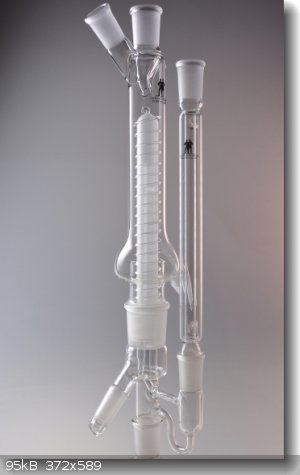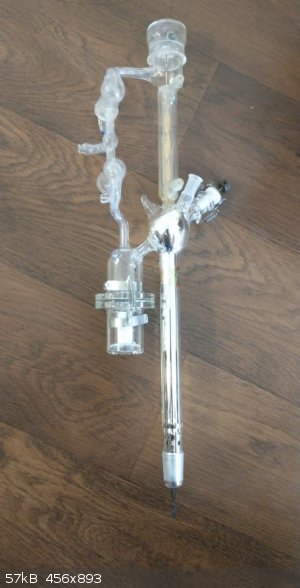CycloRook
Hazard to Self
 
Posts: 89
Registered: 2-4-2018
Member Is Offline
Mood: No Mood
|
|
Can someone explain spinning band and wiped film distillation.
I have a few papers I read that talk about wiped film distillation and spinning band distillation.
I understand spinning band a little bit but don't know anything about wiped film.
Would a short path distillation head do the job of wiped film ?
Can someone post an article with a description of wiped film distillation.
Thanks
|
|
|
Texium
Administrator
       
Posts: 4580
Registered: 11-1-2014
Location: Salt Lake City
Member Is Offline
Mood: PhD candidate!
|
|
Here you go: https://www.popeinc.com/still-products/wiped-film-stills-eva...
All I had to do was Google wiped film distillation and it was on the first page of results… please try a little harder to look in the future.
Terms like these are chemical engineering lingo. It implies use of a specialized apparatus rather than typical lab glassware. No, it doesn't appear
that a short path distillation head does the same job. This “wiped film” setup seems to be an optimization of short path distillation for high
boiling, temperature sensitive substances.
|
|
|
CycloRook
Hazard to Self
 
Posts: 89
Registered: 2-4-2018
Member Is Offline
Mood: No Mood
|
|
Quote: Originally posted by Texium  | Here you go: https://www.popeinc.com/still-products/wiped-film-stills-eva...
All I had to do was Google wiped film distillation and it was on the first page of results… please try a little harder to look in the future.
Terms like these are chemical engineering lingo. It implies use of a specialized apparatus rather than typical lab glassware. No, it doesn't appear
that a short path distillation head does the same job. This “wiped film” setup seems to be an optimization of short path distillation for high
boiling, temperature sensitive substances. |
I read this article but I'm still fuzzy on it. Is it possible to
even obtain such a setup for the average chemist ? Can I substitute another type of distillation ? Can spinning band replace wiped film ?
From what I gather both of these methods are for separation of close BP liquids. I will read more so I understand myself I personally cannot see the
need for these methods if you have a fraction column
|
|
|
Jenks
Hazard to Others
  
Posts: 163
Registered: 1-12-2019
Member Is Offline
|
|
When I was in graduate school, my laboratory had a spinning band distillation setup. Nobody used it as far as I know, but my research director said,
as you mentioned, that it could separate substances with very similar boiling points that weren't separable other ways. The fact that it was there in
a typical UC Davis lab means it might be within the reach of a home chemist, though it might take some searching and luck to find antiquated glassware
looking for a home.
|
|
|
CycloRook
Hazard to Self
 
Posts: 89
Registered: 2-4-2018
Member Is Offline
Mood: No Mood
|
|
"Wiped film distillation is a variation of short path distillation, which can operate in batches or continuous modes. The operation process is simple
yet effective. It's well suited for high production/scale and high throughput because it uses a continuous feed compared to the short path method."
So this looks to be more for production level distillation.
|
|
|
Sulaiman
International Hazard
    
Posts: 3694
Registered: 8-2-2015
Location: 3rd rock from the sun
Member Is Online
|
|
At first I could not understand why the spinning band was invented,
because I have negligible experience with vacuum distillations.
At the very low pressures required to vapourise high molecular weight molecules
below temperatures that may damage them,
the mean free path of molecules becomes comparable to equipment dimensions,
The spinning band 'bats' the molecules of gas into the film of liquid on the wall(s)
So
only useful for low throughput at very low pressures.
I think.
CAUTION : Hobby Chemist, not Professional or even Amateur
|
|
|
CycloRook
Hazard to Self
 
Posts: 89
Registered: 2-4-2018
Member Is Offline
Mood: No Mood
|
|
I have a reaction that used wiped film distillation. Can I substitute short path since it's all I have ?
|
|
|
Metallophile
Hazard to Self
 
Posts: 87
Registered: 23-3-2018
Member Is Offline
Mood: No Mood
|
|
I am a complete novice, but I do know that wiped film is used for Cannabinoid distillation. I assume the purpose is to continually re-expose a fresh
layer of volatiles, from the very viscous starting material.
|
|
|
SWIM
National Hazard
   
Posts: 970
Registered: 3-9-2017
Member Is Offline
|
|
A wiped film distillation setup is uncommon in home labs, but falling film stills are available in smaller sizes and at lower costs.
These are also for distilling sensitive compounds that are too demanding for regular short path distillation.
A large part of this advantage comes from the fact that it is a continuous apparatus: Each tiny portion dripping down the heated central finger is
distilled immediately without having to heat the whole batch up to boiling point first.
Don't know much about wiped stills, but regular falling film stills Don't have any theoretical plates at all.
Material is distilled once and immediately condenses.
Here's a picture of one that looks nicer and cleaner than mine, but is about the same size (24/40).
They make them in 14/20 as well, but I sold my little one on Ebay a few years back at an exorbitant price (maybe $1200?)
Edit: mine has a badly repaired glass spiral (these are the really sensitive part of these two-part falling film stills, and can easily be broken if
you're not VERY careful taking them apart)

[Edited on 28-3-2022 by SWIM]
|
|
|
Texium
Administrator
       
Posts: 4580
Registered: 11-1-2014
Location: Salt Lake City
Member Is Offline
Mood: PhD candidate!
|
|
SWIM: thanks for the good info and explanation. Looks like a really cool apparatus! If I had seen one of those laying around out of context I would
have probably not been able to figure out what it was supposed to do, but with your explanation I can picture it, and I'll definitely keep an eye out
as it sounds rather useful.
|
|
|
SWIM
National Hazard
   
Posts: 970
Registered: 3-9-2017
Member Is Offline
|
|
Another neat thing about them is that the heated finger is heated by refluxing solvent.
This gives a very accurate temperature and a high heat transfer rate as the solvent is being condensed on the inside of the finger (and also in the
condenser which parallels the hot finger. This catches uncondensed solvent that escapes the still head.)
|
|
|
CycloRook
Hazard to Self
 
Posts: 89
Registered: 2-4-2018
Member Is Offline
Mood: No Mood
|
|
So is it safe to say that wiped/falling film cannot be substituted by short path with a vigreaux column ?
[Edited on 29-3-2022 by CycloRook]
|
|
|
Texium
Administrator
       
Posts: 4580
Registered: 11-1-2014
Location: Salt Lake City
Member Is Offline
Mood: PhD candidate!
|
|
Yes! I said that in the first reply in this thread, though clearly that wasn’t the answer you wanted to hear:
Perhaps someone else has a different opinion, but you don’t have to keep asking the same question over and over because most people here actually
read more than the most recent post of a thread.
|
|
|
leau
Hazard to Others
  
Posts: 122
Registered: 3-12-2021
Member Is Offline
|
|
Heat and Mass Transfer Characteristics of a Wiped Film Evaporator
Jacinto Lopez-Toledo
is attached 
Attachment: Dissertation-JLT-2006.pdf (3.4MB)
This file has been downloaded 304 times
|
|
|
CycloRook
Hazard to Self
 
Posts: 89
Registered: 2-4-2018
Member Is Offline
Mood: No Mood
|
|
Quote: Originally posted by Texium  | Yes! I said that in the first reply in this thread, though clearly that wasn’t the answer you wanted to hear:
Perhaps someone else has a different opinion, but you don’t have to keep asking the same question over and over because most people here actually
read more than the most recent post of a thread. |
I did read your post but I'm still so foggy on what any of this means that I didn't understand.
|
|
|
CycloRook
Hazard to Self
 
Posts: 89
Registered: 2-4-2018
Member Is Offline
Mood: No Mood
|
|
Quote: Originally posted by Texium  | Yes! I said that in the first reply in this thread, though clearly that wasn’t the answer you wanted to hear:
Perhaps someone else has a different opinion, but you don’t have to keep asking the same question over and over because most people here actually
read more than the most recent post of a thread. |
My frustration comes from there are several different experiments i would like to conduct and they all use wiped/falling film distillation.
I cannot afford such a setup even the falling film one.
I would like to find a substitute.
To be honest I would actually like to try this method of distillation but again I can't afford it
|
|
|
Tsjerk
International Hazard
    
Posts: 3032
Registered: 20-4-2005
Location: Netherlands
Member Is Offline
Mood: Mood
|
|
And you are sure you absolutely must use wiped film distillation? Maybe you could have shared those papers you're talking about from the beginning
instead asking the same question over and over.
|
|
|
CycloRook
Hazard to Self
 
Posts: 89
Registered: 2-4-2018
Member Is Offline
Mood: No Mood
|
|
Quote: Originally posted by Tsjerk  | | And you are sure you absolutely must use wiped film distillation? Maybe you could have shared those papers you're talking about from the beginning
instead asking the same question over and over. |
ok I'll get them. It's different papers
|
|
|
numos
Hazard to Others
  
Posts: 269
Registered: 22-2-2014
Location: Pasadena
Member Is Offline
Mood: No Mood
|
|
I'll give my two cents on this as well.
I would say whatever it is you are trying to distil via spinning band or wiped still, find another way to do it. I've attached pictures of my
glassware below, a falling film (which I'm familiar with as a molecular still) and a spinning band column.
As swim mentioned, the falling film apparatus is for continuous separation of sensitive compounds. It does not give you a good separation between two
closely boiling compounds. The main advantage is that while a shot path unit has a path length of 10-30 cm, a falling film setup has a path length of
5 mm. So stuff isn't exposed to heat for very long, it's distilled and out it comes. But the disadvantage is that unless the boiling points are farrrr
apart, or you've optimized the hell out of it (no small task), you will not get good separation. Oh and also that the temperature is controlled by
refluxing solvent.... Usually a vacuum distillation run at very high vacuum and low temps can replace this.
The spinning band unit serves an entirely different purpose. They are not interchangeable. As others have mentioned it is for separating compounds
that have very similar boiling points, in fact you can separate two compounds with bps of 148 C and 152 C. This is impossible with other setups. If
you look at the glassware you actually have a gold plated metal band that goes down the entire length of the column. There is a magnet attached to the
top of this so with a motor and complementary magnet you could get the band to spin very, very quickly. This forces the vapor molecules toward the
inner walls of the column. This is ultimately an extreme version of a vigreux or packed column - by maximizing contact with the walls and the band,
you get very fine separation. In this case, forget the cost, even if you had the entire setup you would still need the experience and time to set them
up and use them. I have no clue about the finer details of this device and no one else seems to either. I have heard it takes about a day to set up, a
day to distill, and a day to clean up. This may be exaggerated but who knows...
 
[Edited on 3-30-2022 by numos]
|
|
|
Bmoore55
Hazard to Self
 
Posts: 85
Registered: 23-7-2018
Location: Texas
Member Is Offline
|
|
I actually ran a spinning band unit for years when I worked at a bio fuels company. I was specifically charged with using this apparatus to distill
and separate distinct fractions from a petroleum like product we produced from the pilot process. The benefit of the spinning band distillation
apparatus is to either have the ability to separate very closely boiling compounds or to make a cut at a very distinct temperature. The reason this is
possible is from the increase in theoretical plates that you get from the action of the spinning band inside the column constantly throwing the
volatile gases to the wall of the column. This allows you to have a high theoretical plate count without the burden of having a ridiculously large
column. That way you can have such system placed in a standard building without having the need to cut a hole in the roof to fit your super long
column. These units typically run their first fractions at atmospheric temperatures for say your gasoline range compounds and then switch to vacuum
distillation to isolate the jet and diesel fuel compounds. After this you are left with a residual heavy oil that as various other applications. it is
a really neat piece of kit to run, but it takes all dang day to get done. Hope this helps.
|
|
|
CycloRook
Hazard to Self
 
Posts: 89
Registered: 2-4-2018
Member Is Offline
Mood: No Mood
|
|
Quote: Originally posted by Tsjerk  | | And you are sure you absolutely must use wiped film distillation? Maybe you could have shared those papers you're talking about from the beginning
instead asking the same question over and over. |
Actually after looking it seems most of the processes use
the wiped film evaporator for continuous faster processing. I will try short path myself. I think that spinning band sounds absolutely amazing.
|
|
|